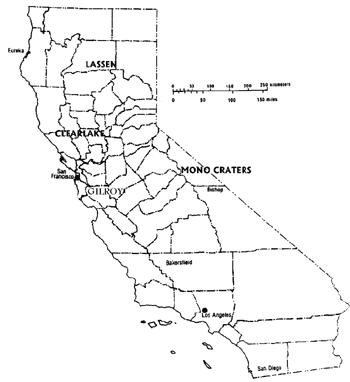BACKGROUND:
There are many different types of igneous rocks. They
all have in common that they were all once melted, and have since cooled
down and become solid. Igneous rocks look different because of two factors:
they cooled at different rates and the "Mother" Magma (original
melted rock) was different. In addition, volcanoes erupt in different ways.
Some extrude quiet lava flows, while others explode violently, blowing lava
into fragments of pumice or scoria. Geologists use these differences as
criteria to name igneous rocks. Rocks that are cooled outside of the volcano
are called volcanic rocks, and those that cool inside the lithosphere are
called plutonic rocks.
Magmas that cool at different rates develop different
sized crystals. Quick cooling volcanic rocks such as lava are composed of
small crystals. For example, basalt has small crystals that can be seen
under a microscope, inferring that basalt cooled quickly. Obsidian is also a
volcanic rock, however, this rock cooled so quickly that no crystals had
time to form. Slow cooling magma inside the Earth creates plutonic rocks
like granite, which is composed of large, visible minerals.
Some of the samples in this lab have a
"holey" or sponge-like appearance. Geologists call this a
vesicular texture and the holes are called vesicles. They form in lava that
contains gas. As the pressure on the lava decreases near or on the Earth’s
surface, the gas forms bubbles. This is physically similar to the bubbles
that happen when a can of soda is opened. In the rock samples the students
will see (pumice and scoria) the gas has long since escaped into the
atmosphere, leaving the holes behind.
PROCEDURE:
- Ask the students if they think that one volcano can produce different
types of rocks. Explain that not all volcanoes are the same. Volcanic
rocks differ in composition and eruptive style. Explain the differences
in appearance between plutonic and volcanic rocks.
 Discuss how to describe igneous rocks by offering the students the
following words: bumpy, glossy, black, red, greenish, holey, grayish.
Review any words that will help them describe the rocks further.
Instruct students to find the locations where these rocks were formed by
using the map of California to the right. Give them the following
information about each location. Ask them if there are enough data
points to conclude if there is a pattern of volcanic rocks in
California. The answer is no. You need more data points to make a
conclusion.
Discuss how to describe igneous rocks by offering the students the
following words: bumpy, glossy, black, red, greenish, holey, grayish.
Review any words that will help them describe the rocks further.
Instruct students to find the locations where these rocks were formed by
using the map of California to the right. Give them the following
information about each location. Ask them if there are enough data
points to conclude if there is a pattern of volcanic rocks in
California. The answer is no. You need more data points to make a
conclusion.
- Here is information on each of the rock types:
Gilroy is south of San Jose. The volcanic rock records volcanism that
occurred millions of years ago. The volcanoes are now extinct. The type
of rock is basalt.
Clearlake is north of the San Francisco Bay Region. The volcanism in
Clearlake was more recent that in Gilroy, and were thought to be
extinct, but recent studies may list this area as "dormant".
The type of rock is obsidian. The Clearlake volcanoes also produced
another type of rock called scoria, or a reddish looking rock.
Mono Craters which produces the pumice, is presently dormant. However
the magma chamber below is still moving upwards and small earthquakes
are common in the area.
Inyo Mountains is along the California-Nevada border north of Death
Valley and south of Mono Craters. This rock is andesite porphyry
and was deposited in the Jurassic. This volcanic complex has long been
extinct.
- The students should conclude that volcanoes produce different types of
rocks. The samples that the students have are insufficient to conclude
if there are differences between a quiet and violent eruption. However,
students may see that some rocks are more "holey" which
represents gas being trapped in the rock which is more common in a
violent eruption.